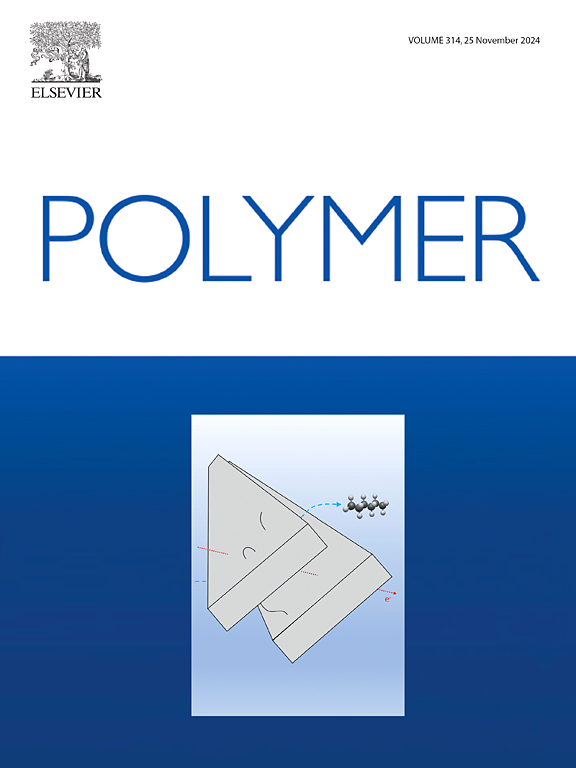Highly stretchable and conductive liquid metal-reinforced interpenetrating polymer network hydrogel for wearable devices
IF 4.5
2区 化学
Q2 POLYMER SCIENCE
引用次数: 0
Abstract
Wearable devices enjoy high convenience and accessibility and thus are especially suitable for everyday health and fitness monitoring and motion detection. Therefore, the device-tissue interface requires bio-compatible, soft, stretchable, and conductive material. For this purpose, we fabricated conductive hydrogel (GPPgel) via in-situ interpenetrating polymerization of polyacrylic acid and polypyrrole, with dispersed gallium-indium-tin liquid metal droplets (GaInSnDs) and iron ions. In GPPgel, the interpenetrating polymer chains are crosslinked via dynamic metal coordinate bonds and hydrogen bonds in addition to π-π bonds. Thus, environmental stress would be dissipated through an energy dissipation mechanism via reversible dissociation of dynamic bonds. As a result, GPPgel displays high ductility (stretching up to 1740 %), high toughness (10.8 MJm−3, G'≈ 400 kPa), high tensile strength (1.85 MPa), low swelling, sufficient adhesiveness, as well as self-healing capability with electrical properties recovering 95.5 % after self-healing, and elasticity with frequency-independent performance. As polypyrrole is conductive on its own, with the help of iron ions and GaInSnDs, the conductivity of GPPgel reaches 2.74 ± 0.2 S/m and linearly changes following the bending of the hydrogel, offering the capability to detect the movement of the wearer. Moreover, it features a rapid strain response time of 104 ms, and maintains stable electrical performance. These performances comprehensively meet the needs of most wearable devices, besides, all the components in GPPgel show good bio-compatibility at the applied level in the hydrogel. Collectively, GPPgel displayed broad-frequency mechanical sensing and biological adaptation characteristics and the strategy of applying liquid metal in hydrogels with an interpenetrating network holds promise for further development.


可穿戴设备用高拉伸导电液态金属增强互穿聚合物网络水凝胶
可穿戴设备具有较高的便利性和可访问性,特别适合日常的健康和健身监测和运动检测。因此,设备-组织界面需要生物相容性、柔软、可拉伸和导电的材料。为此,我们通过聚丙烯酸和聚吡咯的原位互穿聚合制备了导电水凝胶(GPPgel),该凝胶具有分散的镓铟锡液态金属液滴(GaInSnDs)和铁离子。在GPPgel中,除π-π键外,互穿聚合物链还通过动态金属配位键和氢键交联。因此,环境应力将通过动态键可逆解离的能量耗散机制消散。结果表明,GPPgel具有高延展性(拉伸可达1740%)、高韧性(10.8 MJm-3, G′≈400kPa)、高抗拉强度(1.85 MPa)、低溶胀性、良好的粘接性、自愈能力(自愈后电性能恢复95.5%)和频率无关的弹性。由于聚吡咯本身具有导电性,在铁离子和GaInSnDs的帮助下,GPPgel的导电性达到2.74±0.2 S/m,并随着水凝胶的弯曲而线性变化,从而具有检测穿戴者运动的能力。此外,它具有104 ms的快速应变响应时间,并保持稳定的电气性能。这些性能全面满足大多数可穿戴设备的需求,并且GPPgel中的所有组分在水凝胶的应用层面上都表现出良好的生物相容性。综上所述,GPPgel具有广泛的机械传感和生物适应特性,将液态金属应用于具有互穿网络的水凝胶的策略具有进一步发展的前景。
本文章由计算机程序翻译,如有差异,请以英文原文为准。
求助全文
约1分钟内获得全文
求助全文
来源期刊

Polymer
化学-高分子科学
CiteScore
7.90
自引率
8.70%
发文量
959
审稿时长
32 days
期刊介绍:
Polymer is an interdisciplinary journal dedicated to publishing innovative and significant advances in Polymer Physics, Chemistry and Technology. We welcome submissions on polymer hybrids, nanocomposites, characterisation and self-assembly. Polymer also publishes work on the technological application of polymers in energy and optoelectronics.
The main scope is covered but not limited to the following core areas:
Polymer Materials
Nanocomposites and hybrid nanomaterials
Polymer blends, films, fibres, networks and porous materials
Physical Characterization
Characterisation, modelling and simulation* of molecular and materials properties in bulk, solution, and thin films
Polymer Engineering
Advanced multiscale processing methods
Polymer Synthesis, Modification and Self-assembly
Including designer polymer architectures, mechanisms and kinetics, and supramolecular polymerization
Technological Applications
Polymers for energy generation and storage
Polymer membranes for separation technology
Polymers for opto- and microelectronics.
 求助内容:
求助内容: 应助结果提醒方式:
应助结果提醒方式:


